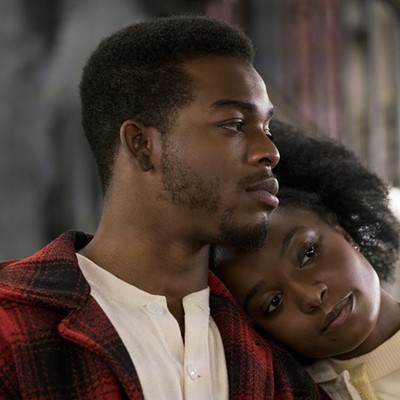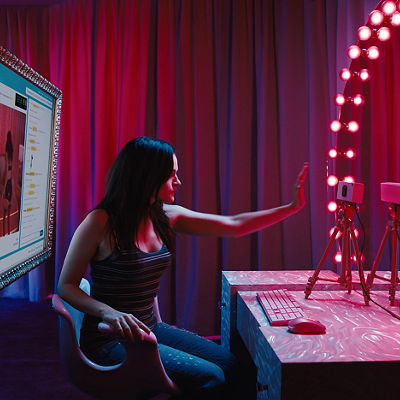Even Kurosawa's most devoted admirers are forced to admit that his subsequent efforts, including Dreams (1990) and Rhapsody in August (1992), are lesser works that add little to his legend. Indeed, Kurosawa's very last film, Madadayo (1993), was widely dismissed as a sentimental trifle, and did not receive even minimal U.S. theatrical exposure until earlier this year, nearly two years after Kurosawa died of a stroke at the age of 88.
In sharp contrast, Ran remains undiminished in its stature as something altogether magnificent -- not so much a film as an elemental force of nature, inspiring awe and exhilaration with its majesty and astonishing beauty. The story behind the story is equally compelling: Even more than Kagemusha (which Kurosawa filmed five years earlier), Ran signaled a triumphant comeback for the director of Rashomon, Yojimbo and The Seven Samurai after a dispiritingly long period of critical and commercial failure. During his darkest days, Kurosawa was so despondent over his perceived obsolescence that in 1971 he attempted suicide. (Remember, this is the man who once warned: "Take myself, subtract movies, and the result is zero.") That Kurosawa survived and thrived -- and created his final masterpiece at the age of 75 -- is the stuff of real-life drama.
Kurosawa completed the Ran screenplay long before the cameras started rolling for Kagemusha. "But it was universally turned down by everyone in Japan," Kurosawa admitted in a 1980 interview. "And not just because of its great expense. There was a superstition among the film industry people that films featuring people in armor, set in this period [the 16th century], would never do well at the box office. So I not only had financial problems to overcome -- I had to overcome superstition as well."
Another obstacle: Kurosawa -- known as Sensei ("Master" or "Teacher") to his many champions, but nicknamed Tenno ("Emperor") by those unimpressed by his autocratic manner -- had fallen into critical disfavor in Japan. He remained sufficiently beloved as a pop-culture figure to command substantial sums for appearing in TV commercials for whiskey and home electronics. But as a sympathetic New York Times writer noted at the time: "Younger [Japanese] critics tend to regard him as an anachronism. His humanistic concerns and worship of classical art seem out of place in postmodern Tokyo."
Undeterred, Kurosawa wrote Kagemusha, his stirring period drama about a bandit who doubles for a slain warlord, "because I needed something that would be less expensive to film," he said. "And all the while I was filming it, I was thinking of how to use horses, how to handle the locations, and how to direct the people in the armor. It became overall an exercise to see how I would complete Ran."
Unfortunately Kurosawa found it difficult to raise even a drastically reduced budget to film a downsized epic that might serve as a "test run" for his magnum opus. During this period, he considered, then rejected, the offer of easy money for directing Shogun, the American-produced miniseries based on James Clavell's novel. ("It seemed so far from the truth of any historical events in Japan, and I was so shocked by this that I did not think it was an appropriate thing for me to do.") But just when despair threatened to overwhelm him once again, the emperor received assistance from two loyal subjects.
During a brief visit to San Francisco, Kurosawa casually mentioned to a couple of guys named George Lucas and Francis Ford Coppola that he was having trouble raising the $6 million budget for Kagemusha. By Hollywood standards, $6 million was a meager sum. At the time, however, it would have made Kagemusha the most expensive film ever produced in Japan.
So what happened? Shortly after Kurosawa returned home, Lucas and Coppola convinced 20th Century Fox to purchase Kagemusha for all areas outside Japan. This was a precedent-setting arrangement. For the first time, distribution rights for a Japanese film had been sold to a major Hollywood distributor before production had begun. Kurosawa recognized, with profoundly mixed emotions, that it was this show of interest from abroad, not his own reputation, that convinced Japanese producers to pony up the rest of the budget.
Kagemusha was modestly successful in theatrical release, and earned an Academy Award nomination for Best Foreign Film. But when Kurosawa resumed preparations for Ran, he found that even turning a profit with his test run wasn't enough to entirely convince Japanese producers. Once again, he turned to outsiders for help: Ran, which ultimately cost $11.5 million, was made only after French co-producers invested in the enterprise.
Ran -- the title loosely translates as "chaos" -- clearly is the work of a man who has lived long and learned much, but who never has ceased to be amazed by the human capacity for deceit and destruction. And it just as clearly is the work of a man who has reached the point where he feels compelled to refute his once-cherished illusions. Forget about the noble warriors of Seven Samurai or the rousing antiheroics of Yojimbo. In Ran, Kurosawa emphasizes timeless and terrifying truths: War is slaughter, warriors are murderers, and blood will have blood. God has nothing to do with it -- he might weep or rage, but we keep killing each other anyway.
And yet, when discussing Ran shortly before its premiere at the 1985 New York Film Festival, Kurosawa insisted his epic was, ultimately, optimistic. To be sure, he acknowledged, "Many people have accused me of a certain amount of pessimism. But I don't believe that's true of this film. I believe that it is necessary to look desperation in the face. They say that pessimism is when you cannot see beyond your immediate desperation. But if you stare desperation in the face, this is the only way to see the happiness that lies beyond it.
"The farthest thing from my mind while I'm making a film is to teach anybody anything. I have no desire to impose my personal philosophy on my audience. But I do feel that the world as a whole has come to such a pass that our situation is tragic. I feel it is therefore of great importance to encounter this desperate situation face-to-face, and not turn away from it, in order to find a way out, to find the light of a new beginning."
While preparing his enlightening tragedy, Kurosawa once again sought inspiration from William Shakespeare, who previously provided Kurosawa with source material for Throne of Blood (a 1957 re-imagining of Macbeth) and The Bad Sleep Well (an audacious 1960 update of Hamlet). Kurosawa initially intended to spin a story based on the life of Motonari Mori, the 16th-century warlord whose three sons still are revered in Japan as models of filial virtue. As he progressed, however, the legendary filmmaker was intrigued by the idea of turning history on its head: What, he wondered, would have happened had Mori's sons been more like Lear's daughters?
"I had already done a straight adaptation of Shakespeare, Macbeth as Throne of Blood. But my view of Lear is that he must be the opposite phenomenon. Macbeth begins as a fairly good person, and over the course of the play, with the intensification of his ambition, he becomes a very evil person. Though it isn't stated in King Lear, I feel that Lear starts out at the point where Macbeth finishes. The evils have all been done. And the development of his character is toward the good, as he throws away all his ambitions for power. This comparison is something that interested me greatly. In Shakespeare's play, the character of Lear never reflects on his own past. He doesn't seem to understand why things are happening to him the way they do. But I feel that a reason for his madness in the play is that his evil past is coming back on him. Unless I interpret it this way, I cannot justify what happens to him."
In Ran, King Lear morphs into Lord Hidetora (Tatsuya Nakadai, star of Kagemusha), the aging ruler of a land forcefully united through wars and repression. Hoping to enjoy the fruits of his violent labors, he announces his intention to abdicate the throne and to turn authority over to his eldest son, Taro (Akira Terao). "It is time to stable the steeds of war," Hidetora grandly announces, "and give free rein to peace." But the steeds don't stay stabled for long.
The trouble begins when Taro's manipulative wife, Kaede (Mieko Harada), encourages her husband to solidify his new status by stripping Hidetora of his largely symbolic titles and perks. Jiro (Jinpachi Nezu), Hidetora's second son, also wants Hidetora neutralized. More important, he also wants Taro's throne. Jiro is willing to kill to fulfill his ambitions. But even at his worst, he's no match for Kaede, who turns out to be, in the tradition of Throne of Blood, another Lady Macbeth clone. Kaede seduces Jiro -- at knifepoint -- then eggs her husband's killer into a rash war against Hidetora's one faithful son, Saburo (Daisuke Ryu). Nothing good comes of this.
Ran abounds with breathtaking set pieces: the fiery assault on Hidetora's Third Castle, and the killing of his retainers by the armies of his traitorous sons; the tumultuous battle scenes, masterpieces of boldly inventive editing and composition; and perhaps most haunting, Hidetora's excruciatingly long descent from a burning tower to a courtyard filled with soldiers. Hidetora, his lined face and red-rimmed eyes suggesting the mask of a Noh tragedian, isn't bothered much by the troops; he looks so much like a ghost, they're too frightened to kill him.
The genius of Kurosawa's Ran is that for all its scenes of death and destruction, it does indeed point a way toward higher ground. By showing the worst that men can do, Kurosawa also suggests a possibility for nobility and redemption. By destroying all illusions, he nevertheless revives hope.
To give Akira Kurosawa the last word on the subject: "The character of Hidetora begins at the point of the pinnacle of worldly power and confidence -- as a result of having carried out unspeakable deeds throughout his life to attain that power. What happens to him in the course of the film is he is forced to pay for his misdeeds. And it is at the point where he has almost fallen to the depths of misery and desperation -- when he is being treated not like a great warrior, but like a beggar -- that he arrives at his first understanding of what is important in life. Through his downfall, he attains a kind of purity and has his first glimpse of clear blue sky when he realizes that all he really needs is the love and understanding of one faithful son.
"So his death, for me, is the most pitiful, and at the same time the most magnificent, that I feel I have been able to conceive in my films. And if there are gods and angels at that moment, they are probably leaning forward and putting his halo on his head."





